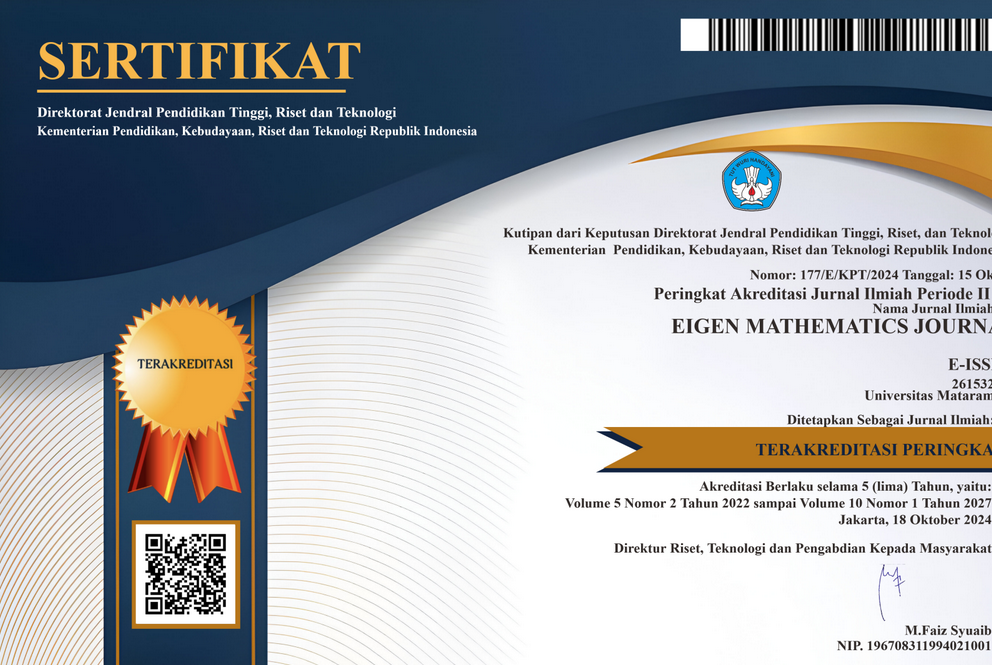Modeling the Number of Infant Mortality in East Lombok using Geographically Weighted Poisson Regression
DOI:
https://doi.org/10.29303/emj.v5i2.138Keywords:
Geographically Weighted Poisson Regression, Infant MortalityAbstract
Infant mortality is death that occurs at the age of 0 to 1 year. According to the Provincial Health Office, East Lombok is the district with the largest infant mortality rate in NTB. Several factors influence infant mortality: childbirth with medical assistance, low birth weight, health facilities, health workers, and exclusive breastfeeding. These factors have a spatial influence because each region has different geographical, socio-cultural, and economic conditions. Therefore, the method that can be used is GWPR because it can model data with the response variable with a Poisson distribution and pay attention to location or spatial aspects. This study aims to determine the infant mortality model in East Lombok using Geographically Weighted Poisson Regression (GWPR) and to determine the factors that significantly influence the number of infant deaths in East Lombok. Based on the research conducted showed that low birth weight is the only factor that significantly affected infant mortality in 8 sub-districts, including Keruak, Sakra, West Sakra, East Sakra, Terara, Sukamulia, Selong, and Labuhan Haji. The model obtained gives a good estimator, with an R^2 value of 76,44%.References
Agustina, M. F., Wasono, R., & Darsyah, M. Y. (2015). Pemodelan Geographically Weighted Regression (GWR) pada Tingkat Kemiskinan di Provinsi Jawa Tengah. Statistika, 3(2), 67–74.
Badan Pusat Statistik (BPS). (2022). Sistem Informasi Rujukan Statistik (SIRuSa), https://sirusa.bps.go.id/sirusa/, diakses pada November 2022.
Destyanugraha, R. & Kurniawan, R. (2017). Pemodelan Angka Kematian Ibu Di Indonesia Dengan Pendekatan Geographically Weighted Poisson Regression (Modeling of Maternal Mortality Rate in Indonesia Using Geographically Weighted Poisson Regression Approach). Jurnal Matematika Sains Dan Teknologi (Journal of Mathematical Science and Technology), 18(2), 76–94.
Dinas Kesehatan Provinsi NTB (Dikes NTB). (2020). Profil Kesehatan NTB 2019. 183.
Elyana, M.A.K., Srinadi, I.G.A.M., Susilawati, M. (2012). Pemodelan Angka Kematian Bayi Dengan Pendekatan Geographically Weighted Poisson Regression Di Provinsi Bali. E-Jurnal Matematika, 1(1), 94–98.
Fadlilah, I. M. & Sunarmi, S. (2019). Estimasi Parameter Model Regresi Spasial dengan Metode Geographically Weighted Poisson Regression. UNNES Journal of Mathematics, 8(2), 21–31.
Fotheringham, A.S., Brunsdon, C. & Charlton, M. (2002). Geographically Weighted Regression: The Analysis of Spatial Varying Relationships. John Wiley & Sons, England.
Hairunnisa, Hadijati, M., & Fitriyani, N. (2022). Application of Geographically Weighted Lasso Method in The Case of Gross Regional Domestic Product For The Bali Nusra Region. Konferensi Nasional Matematika XXI 2022, Mataram, Indonesia.
Haris, M., Yasin, M., & Hoyyi, A. (2015). Kejahatan Pencurian Kendaraan Bermotor (Curanmor) Menggunakan Metode Geographically Weighted Poisson. Concept and Communication. null(23), 301–316.
Lokang, Y. P. & Dwiatmoko, I. A. (2019). Analisis Regresi Spasial Durbin Untuk Menganalisis Faktor-faktor yang Berhubungan dengan Persentase Penduduk Miskin. Jurnal Ilmiah MATRIK, 21(2), 118–127.
Lutfiani, N., Sugiman, & Mariani, S. (2017). Pemodelan Geographically Weighted Regression (GWR) dengan Fungsi Pembobot Kernel Gaussian dan Bisquare. UNNES Journal of Mathematics, 5(1), 82–91.
Pamungkas, R. A., Yasin, H., & Rahmawati, R. (2016). Perbandingan Model GWR Dengan Fixed dan Adaptive Bandwidth Untuk Persentase Penduduk Miskin Di Jawa Tengah. Jurnal Gaussian, 5(3), 535–544.
Prajanati, M.S.A., Harsyiah, L., & Fitriyani, N. (2022). Model of Human Development Index in West Nusa Tenggara Province using Geographically Weighted Ridge Regression Method (GWRR). The 3rd International Conference on Natural Sciences, Mathematics, Applications, Research and Technology (ICON-SMART), Bali, Indonesia.
Pratama, A. (2017). Model Simulasi Antrian Dengan Metode Kolmogorov-Smirnov Normal Pada Unit Pelayanan. Edik Informatika, 3(1), 27–37.
Qolbiatunas, N. P. & Nugraha, J. (2018). Pendekatan model Geographically Weighted Regression pada Jumlah Produksi Padi di Jawa Barat. Prosiding Seminar Nasional Matematika Dan Pendidikan Matematika, 212–223.
Septiani, I. N. (2021). Pemodelan Jumlah Kematian Bayi dengan Pendekatan Geographically Weighted Poisson Regression (GWPR) Studi Kasus di Provinsi Kalimantan Barat. Buletin Ilmiah, 10(1), 99–108.
Sumarni, I.D., Fitriyani, N., & Baskara, Z.W. (2022). Modeling of Factors Affecting Poverty in West Nusa Tenggara Province in 2020 With Geographically Weighted Logistic Regression Konferensi Nasional Matematika XXI 2022, Mataram, Indonesia.
Tibshirani, R. (1996). Regression shrinkage and selection via the lasso. Journal of the Royal Statistical Society: Series B (Methodological), 58(1), 267-288.
Downloads
Published
How to Cite
Issue
Section
License

This work is licensed under a Creative Commons Attribution-NonCommercial-ShareAlike 4.0 International License.
All articles published in the Eigen Mathematics Journal will be available for free reading and downloading. The license applied to this journal is Creative Commons Attribution-Non-Commercial-Share Alike (CC BY-NC-SA).
Most read articles by the same author(s)
- Baiq Siti Patimah Zohrah, Syamsul Bahri, Zulhan Widya Baskara, Forecasting Non-Metal and Rock Mineral (MBLB) Tax Revenue Using the Fuzzy Time Series Markov Chain Method in East Lombok Regency , EIGEN MATHEMATICS JOURNAL: Vol. 7 No. 1 (2024): June
- Putri Rahmasari Rayes, Nuzla Af'idatur Robbaniyyah, Syamsul Bahri, Implementation of Fast Fourier Transform and Least Mean Square Algorithms in The Denoising Process of Audio Signal , EIGEN MATHEMATICS JOURNAL: Vol. 8 No. 1 (2025): June
- Muhammad Rizaldi, Nurul Fitriyani, Zulhan Widya Baskara, Modeling of Economic Growth Rate in West Nusa Tenggara Province with Longitudinal Kernel Nonparametric Regression , EIGEN MATHEMATICS JOURNAL: Vol. 7 No. 1 (2024): June






